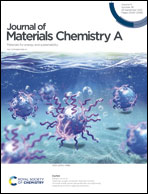Cu-incorporated PtBi intermetallic nanofiber bundles enhance alcohol oxidation electrocatalysis with high CO tolerance†
Abstract
Atomically ordered intermetallic nanomaterials represent one class of the most attractive catalysts for direct alcohol fuel cells, whereas they remain arduous owing to both the complexity of conventional synthetic approaches and their susceptibility to intermediates (especially CO). Herein, a facile one-step surfactant-free strategy is reported for producing Cu-incorporated PtBi intermetallic nanofiber bundles (Cu–PtBi NFBs) served as robust electrocatalysts towards bifunctional methanol and ethanol oxidation reactions (MOR and EOR). The resultant Cu–PtBi NFBs not only achieve remarkable CO tolerance, and superior mass and specific activities (6.79 A mgPt−1 and 11.26 mA cm−2) with a maximum onset potential shift (77 mV) relative to commercial Pt/C for the MOR, but also show 4.3-fold improved EOR mass activity (4.00 A mgPt−1) compared to commercial Pt/C. X-ray absorption fine structure analysis and density functional theory simulation corroborate that the ordered PtBi-based hexagonal close-packed structure, as well as the Cu-induced bifunctional effect, is key to substantially weakening the bonding strength between CO* and Pt sites and strengthening the anchoring of OH* on adjacent Cu sites, thereby optimizing the CO-poisoning pathway. This work provides an effective design strategy for Pt-based intermetallic nano-electrocatalysts as high-efficiency anodic materials in fuel cell applications.



 Please wait while we load your content...
Please wait while we load your content...